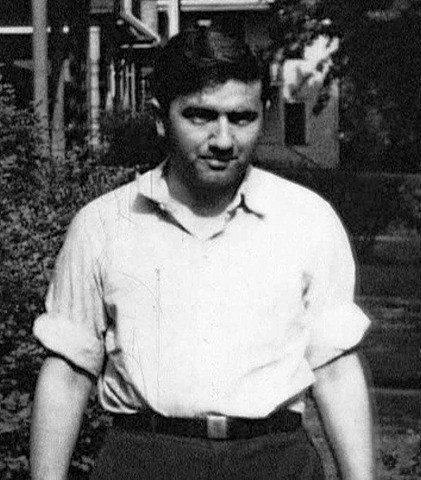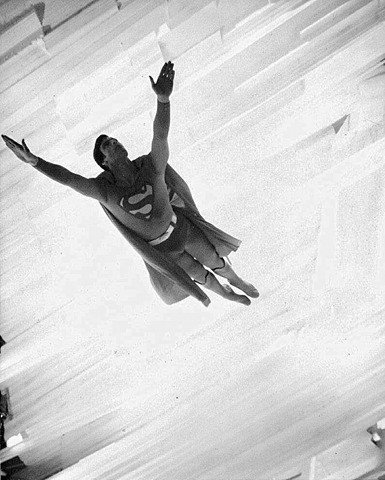The History of Comics, Courtesy of Superman By Matthew Rizzuto
Within the realm of my personal opinion, those who can identify the history of comics know a thing or two about greatness. As you’re well aware, a photograph is a universe of dots. The grain, the halide, the little silver things clumped in the emulsion. Once you get inside a dot, you gain access to hidden information, you slide inside the smallest event. This is what technology does. It peels back the shadows and redeems the dazed and rambling past. It makes reality come true. From the 1930’s to the 1980’s, comic book art and comic books were the same thing. In the decades since, the art of comics has been carefully separated from the original physical conditions of its reproduction. Elevation of the 20th Century art form has resulted in the erasure of the 20th Century mechanical processes that enabled comic books to exist and thrive for ten, twelve, fifteen or twenty cents, millions of times over. It was an economic bargain that significantly defined the aesthetic terms of comic books: Cheap paper, cheap printing and four-color separations that could not hide their limitations. These accidental aesthetics governed the experience of comics for generations, were appropriated for fine art in the 1960’s and today fall into the “retro” category of graphic design.
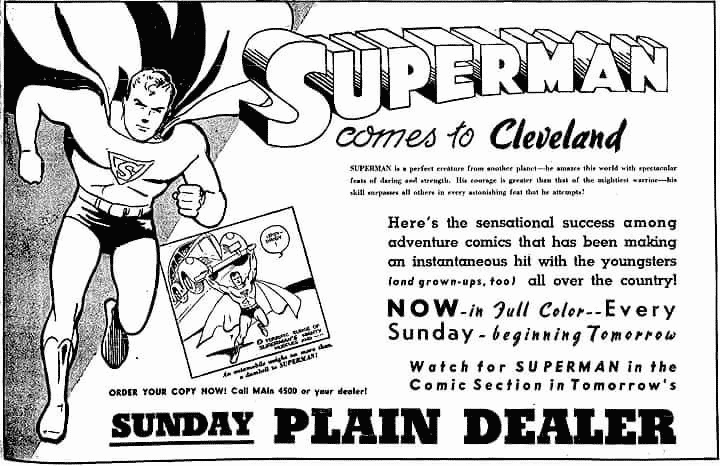
Four-color process and mid-20th Century comic art have gone their separate ways – one travelling as a computer-assisted simulation of archaic print culture and the other as computer-assisted art books, featuring crisp black lines, bleed-free white paper and “reconstructions” of the original colorists designs. Hard to believe, there are no stakes in privileging one comic book reproduction format over the other, but there is no denying the difference between the two. One way to think about the astounding art is as an examination of this difference. It tries to minimize what we think of as the content of comic books, while radically magnifying the four-color process itself. At their original size, all the images in the gallery would cover a few square feet of printed comic book space. Blown up to monumental proportions, many of these minute fragments could fill a two-page spread. Gone are the page, the panel, the plot and localized contextual meaning. What remain are the color process and what are generally called the “details” of comic book art. These are the two lowest items on the totem pole of comic book value. Poor reproduction and the least important, most static elements of the art itself. Our proposition is that these elements are important and aesthetically compelling.
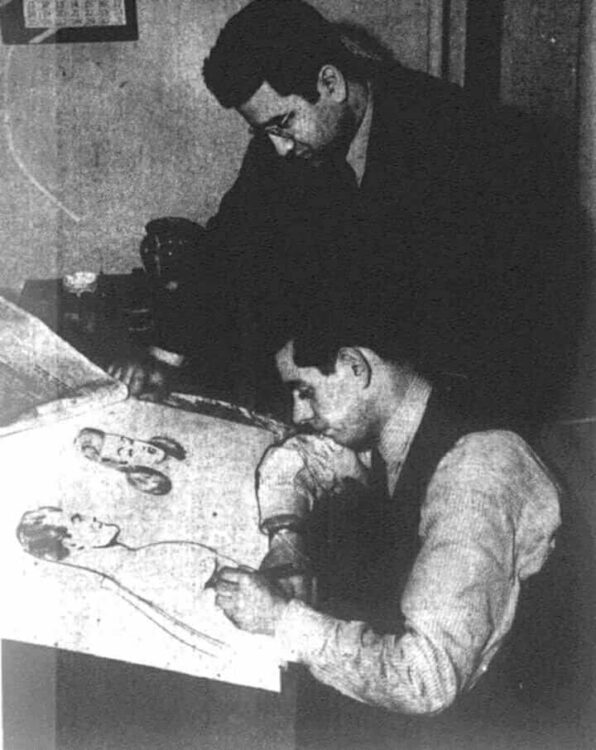
In many respects, that’s why I incredibly admire The Golden Age of Comics. The creativity of the writers and artists was endless!!! You see, comics have been in existence since the end of the 19th Century, but it was after The Great Depression that the popularity of newspaper cartoons expanded into a major industry, at least, as we know it currently. The precise era of the Golden Age is disputed, though most agree that it was born with the launch of Superman in 1938. Created by Cleveland’s own, Jerry Siegel and Joe Shuster, Superman is possibly the most recognizable comic book character and superhero to this day. In fact, within the realm of my personal opinion, without Superman, the comics industry as we know it currently, does not exist. The success of Jerry Siegel
and Joe Shuster’s
Superman spawned a series of spin-offs and created a whole new genre of characters with secret identities, superhuman powers and colorful outfits – the superhero. Batman and Robin The Boy Wonder, Wonder Woman, Plastic Man, The Human Torch, Namor The Sub-Mariner, Aquaman, Hawkman, The Spectre, Green Lantern, Flash and Captain America were amongst those who followed. Captain Marvel proved to be one of the most popular superhero comics of the Golden Age, regularly outselling the adventures of Superman during the 1940’s. The sales of comic books increased markedly during World War II. They were cheap, portable and had inspirational, patriotic stories of good triumphing over evil. The tales very much reflected the events and values of the time. Pro-American characters were popular, particularly Captain America, a superhero whose entire creation was based on aiding the country’s war effort. Sporting the stars and stripes as his costume, Captain America was pictured battling noted scumbag Adolf Hitler on the cover of the very first issue.

Though the superhero comics were the top sellers, other genres emerged during the Golden Age. Horror and crime were popular, notably Will Eisner’s The Spirit, a masked detective who captured villains and dispensed Justice. Science fiction and Western-themed comics were some of the new styles of storytelling that started to appear. The teen genre was also gaining interest. A comic strip featuring a red-head named Archibald “Archie” Andrews debuted in 1941, becoming so popular the company that created it changed its name to Archie Comics in 1946.
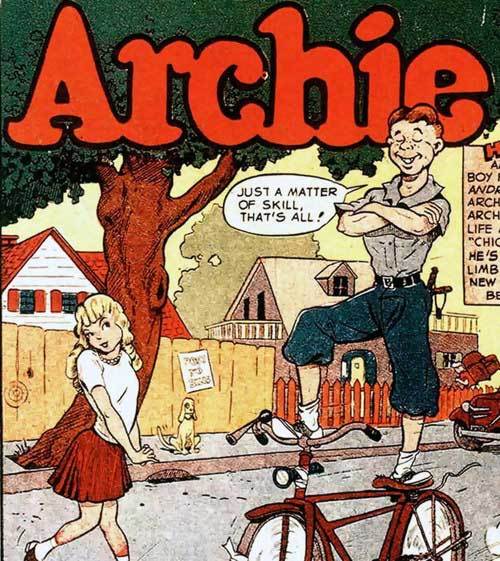
Animal and jungle themed comics were led by Walt Disney, featuring Mickey Mouse, Donald Duck and Edgar Rice Burroughs’ Tarzan. In fact, let’s not forget, that the creator of Tarzan, Edgar Rice Burroughs, was a huge fan of Superman.

After World War II, the superhero genre lost steam, marking what many consider to be the end of the Golden Age. The era itself, though, left an indelible mark on comic books with many of the characters remaining popular 80 years later.
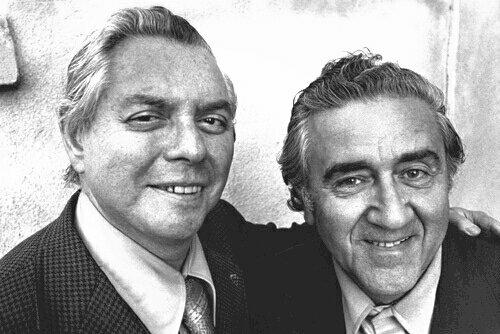
The first superhero, Superman is still alive and well in popular culture today. Perhaps, one of the most important impacts of the Golden Age was the cementation of the comic as a mainstream artform, with its own defined language and creative conventions. Courtesy of movies, that is possible with comics. Everything came together between comics and movies in 1978. The tagline from the 1978 box office smash film is accurate: “You’ll Believe A Man Can Fly.”
Nothing you have ever seen or heard, no comic book, television program, movie serial, radio show, Broadway production, cartoon or motion picture could ever prepare you for this reality. It’s a brilliant cast in an unforgettable story. The awesome technology of modern films brings you someone to believe in.
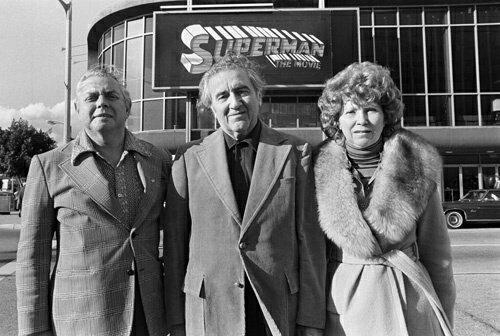
Revolutionary Academy Award-winning Visual Effects, a genuine romance between Superman and his favorite girl reporter Lois Lane, John Williams captivating score which resonances to this day, the legendary Marlon Brando as The Man of Steel’s Kryptonian father Jor-El, a spine-tingling and mesmerizing story by Mario Puzo and screenplay by Tom Mankiewicz, Christopher Reeve looking like he’s just stepped off the DC comic book page and all of that and so much more is the specific reason why people enjoy and love Richard Donner’s Oscar®-winning, epic masterpiece, “Superman: The Movie” (1978).
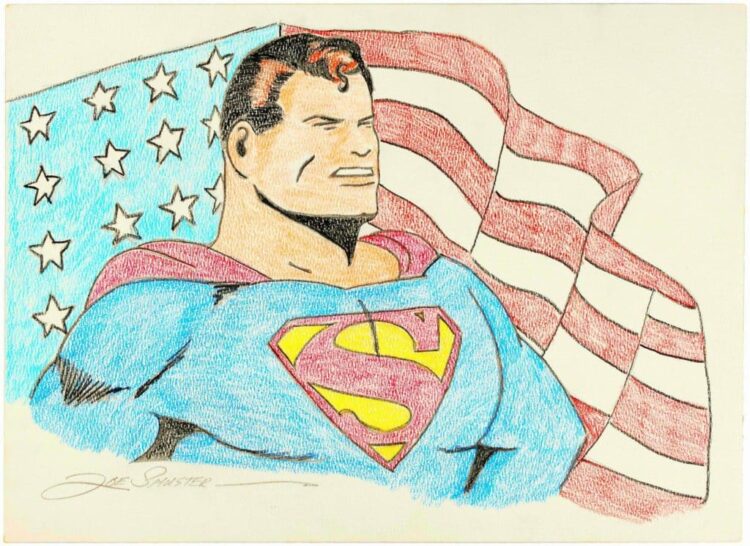
How did all this begin? We must remember that a comic book or comics also called comic magazine or simply comic, is a publication that consists of comic art in the form of sequential juxtaposed panels that represent individual scenes. Panels are often accompanied by brief descriptive prose and written narrative, usually dialog contained in word balloons emblematic of the comics art form. Although comics has some origins in 18th Century Japan, comic books were first popularized in the United States of America and the United Kingdom during the 1930’s. The first modern comic book, Famous Funnies, was released in America in 1933 and was a reprinting of earlier newspaper humor comic strips, which had established many of the storytelling devices used in comics. The term comic book derives from American comic books once being a compilation of comic strips of a humorous tone. Yet, this practice was replaced by featuring stories of all genres, usually not humorous in tone. The largest comic book market is Japan. By 1995, the manga market in Japan was valued at ¥586.4 billion ($6–7 billion), with annual sales of 1.9 billion manga books/magazines in Japan (equivalent to 15 issues per person). The comic book market in the United States of America and Canada was valued at $1.09 billion in 2016. Comic books are reliant on their organization and appearance. Authors largely focus on the frame of the page, size, orientation and panel positions. These characteristic aspects of comic books are necessary in conveying the content and messages of the author. The key elements of comic books include panels, balloons (speech bubbles), text (lines) and characters. Balloons are usually convex spatial containers of information that are related to a character using a tail element. The tail has an origin, path, tip and pointed direction. Key tasks in the creation of comic books are writing, drawing and coloring.
American Comic Books: Comics as a print medium have existed in America since the printing of The Adventures of Mr. Obadiah Oldbuck in 1842 in hardcover, making it the first known American prototype comic book. Proto-comics periodicals began appearing early in the 20th Century, with historians generally citing Dell Publishing’s 36-page Famous Funnies: A Carnival of Comics as the first true American comic book; Goulart, for example, calls it “the cornerstone for one of the most lucrative branches of magazine publishing”. The introduction of Jerry Siegel and Joe Shuster’s Superman on April 18, 1938 turned comic books into a major industry and ushered the Golden Age of Comics. The Golden Age originated the archetype of the superhero. Historians generally divide the timeline of the American comic book into eras. The Golden Age of Comic Books began in the 1930’s, which is generally considered the beginning of the comic book that we know today. The Silver Age of comic books is generally considered to date from the first successful revival of the then-dormant superhero form, with the debut of The Flash in Showcase #4 (October 1956). The Silver Age lasted through the late 1960’s or early 1970’s, during which time Marvel Comics revolutionized the medium with such naturalistic superheroes as Stan Lee and Jack Kirby’s Fantastic Four and Lee and Steve Ditko’s Spider-Man. The demarcation between the Silver Age and the following era, the Bronze Age of Comic Books, is less well-defined, with the Bronze Age running from the very early 1970’s through the mid-1980’s. The Modern Age of Comic Books runs from the mid-1980’s to the present day. A notable event in the history of the American comic book industry was initiated with psychiatrist and full-time imbecile Dr. Fredric Wertham’s criticisms of the medium of comics in his book, Seduction of The Innocent (1954), which prompted the American Senate Subcommittee on Juvenile Delinquency to investigate comic books. In response to attention from the government and from the media, the U.S. comic book industry set up the Comics Magazine Association of America. The CMAA instilled the Comics Code Authority in 1954 and drafted the self-censorship Comics Code that year, which required all comic books to go through a process of approval. It wasn’t until the 1970’s that comic books could be published without passing through the inspection of the CMAA. The Code was made formally defunct in 2011.
Underground Comix: In the late 1960’s and early 1970’s, a surge of creativity emerged in what became known as underground comix. Published and distributed independently of the established comics industry, most of such comics reflected the youth counterculture and drug culture of the time. Many had an uninhibited, often irreverent style; their frank depictions of nudity, sex, profanity and politics had no parallel outside their precursors, the pornographic and even more obscure “Tijuana Bibles”. Underground comics were almost never sold at newsstands, but rather in such youth-oriented outlets as head shops and record stores, as well as by mail order. Frank Stack’s The Adventures of Jesus, published under the name Foolbert Sturgeon, has been credited as the first underground comic; while R. Crumb and the crew of cartoonists who worked on Zap Comix popularized the form. Alternative Comics: The rise of comic book specialty stores in the late 1970’s created/paralleled a dedicated market for “independent” or “alternative comics” in the U.S. The first such comics included the anthology series, Star Reach, published by comic book writer Mike Friedrich from 1974 to 1979 and the legendary Harvey Pekar’s American Splendor, which continued sporadic publication into the 21st Century and which Shari Springer Berman and Robert Pulcini adapted into the 2003 film. Some independent comics continued in the tradition of underground comics. While their content generally remained less explicit, others resembled the output of mainstream publishers in format and genre, but were published by smaller artist-owned companies or by single artists. A few (notably RAW) represented experimental attempts to bring comics closer to the status of fine art. During the 1970’s, the “small press” culture grew and diversified. By the 1980’s, several independent publishers – such as Pacific, Eclipse, First, Comico and Fantagraphics – had started releasing a wide range of styles and formats—from color-superhero, detective and science fiction comic books to black-and-white magazine-format stories of Latin American magical realism. A number of small publishers in the 1990’s changed the format and distribution of their comics to more closely resemble non-comics publishing. The “minicomics” form, an extremely informal version of self-publishing, arose in the 1980’s and became increasingly popular among artists in the 1990’s, despite reaching an even more limited audience than the small press. Small publishers regularly releasing titles include Avatar Comics, Hyperwerks, Raytoons and Terminal Press, buoyed by such advances in printing technology as digital print-on-demand.
Graphic Novels: In 1964, Richard Kyle coined the term “graphic novel”. Precursors of the form existed by the 1920’s, which saw a revival of the medieval woodcut tradition by Belgian Frans Masereel, American Lynd Ward and others, including Stan Lee. In 1950, St. John Publications produced the digest-sized, adult-oriented “picture novel”, It Rhymes With Lust, a 128-page digest by pseudonymous writer “Drake Waller” (Arnold Drake and Leslie Waller), penciler Matt Baker and inker Ray Osrin, touted as “an original full-length novel” on its cover. In 1971, writer-artist Gil Kane and collaborators devised the paperback “comics novel”, Blackmark. Will Eisner popularized the term “graphic novel” when he used it on the cover of the paperback edition of his work, A Contract with God and Other Tenement Stories in 1978.
Market Size: In 2017, the comic book market size for North America was just over $1 billion with digital sales being flat, book stores having a 1 percent decline and comic book stores having a 10 percent decline over 2016.
Comic Book Collecting: The 1970’s saw the advent of specialty comic book stores. Initially, comic books were marketed by publishers to children because comic books were perceived as children’s entertainment. However, with increasing recognition of comics as an art form and the growing pop culture presence of comic book conventions, they are now embraced by many adults. Comic book collectors are often lifelong enthusiasts of the comic book stories and they usually focus on particular heroes, superheroes and attempt to assemble the entire run of a title. Comics are published with a sequential number. The first issue of a long-running comic book series is commonly the rarest and most desirable to collectors. The first appearance of a specific character, however, might be in a pre-existing title. For example, Spider-Man’s first appearance was in Amazing Fantasy #15. New characters were often introduced this way and did not receive their own titles until there was a proven audience for the hero. As a result, comics that feature the first appearance of an important character will sometimes be even harder to find than the number 1 issue of a character’s own title. Some rare comic books include copies of the unreleased Motion Picture Funnies Weekly #1 from 1939. Eight copies, plus one without a cover, emerged in the estate of the deceased publisher in 1974. The “Pay Copy” of this book sold for $43,125 in a 2005 Heritage auction. The most valuable American comics have combined rarity and quality with the first appearances of popular and enduring characters. Four comic books have sold for over $1 million USD as of December 2010, including two examples of Action Comics #1, the first appearance of Superman, both sold privately through online dealer ComicConnect.com in 2010 and Detective Comics #27, the first appearance of Batman, via public auction. Updating the above price obtained for Action Comics #1, the first appearance of The Man of Steel, the highest sale on record for this book is $3.2 million, for a 9.0 copy. Misprints, promotional comic-dealer incentive printings and issues with extremely low distribution also generally have scarcity value. The rarest modern comic books include the original press run of The League of Extraordinary Gentlemen #5, which DC executive Paul Levitz recalled and pulped due to the appearance of a vintage Victorian era advertisement for “Marvel Douche”, which the publisher considered offensive because only 100 copies exist, most of which have been CGC graded. In 2000, a company named Comics Guaranty (CGC) began to “slab” comics, encasing them in a thick plastic and giving them a numeric grade. As of 2014, there are two companies that provide third party grading of comic book condition. Because condition is so important to the value of rare comics, the idea of grading by a company that does not buy or sell comics seems like a good one. Shockingly enough, there is some controversy about whether this grading service is worth the high cost and whether it is a positive development for collectors or if it primarily services speculators who wish to make a quick profit trading in comics as one might trade in stocks or fine art. Comic grading has created valuation standards that online price guides such as GoCollect and GPAnalysis have used to report on real-time market values. The original artwork pages from comic books are also collected, and these are perhaps the rarest of all comic book collector’s items, as there is only one unique page of artwork for each page that was printed and published. These were created by a writer, who created the story; a pencil artist, who laid out the sequential panels on the page; an ink artist, who went over the pencil with pen and black ink; a letterer, who provided the dialogue and narration of the story by hand lettering each word; and finally a colorist, who added color as the last step before the finished pages went to the printer. When the original pages of artwork are returned by the printer, they are typically given back to the artists, who sometimes sell them at comic book conventions or in galleries and art shows related to comic book art. The original pages of the first appearances of such legendary characters as Superman, Batman, Wonder Woman and Spider-Man are considered unbelievably priceless.
All of that and so much more now currently exists because of the invention of Jerry Siegel and Joe Shuster’s Superman.
Thank You.
The History of Comics, Courtesy of Superman By Matthew Rizzuto, Superman Comic Book Historian.
join us for more discussion at the CBH Facebook group
get historic comic CBH Merchandise
check out the CBH Youtube Channel
check out the CBH Podcast available on Apple Podcasts, Google PlayerFM and Stitcher.
Use of images are not intended to infringe on copyright, but merely used for academic purpose.
Photos and Pictures ©Their respective copyright holders, Superman DC Comics, Archie ©Archie Comics, Captain America ©Marvel Comics, Superman Move ©Warner Brothers
The opinions of any one article do not reflect the intentions of the website.








